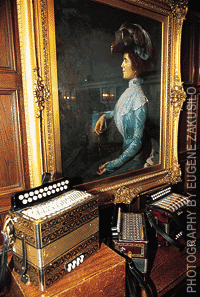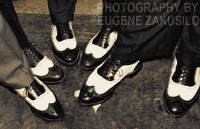The
40th Annual University of Chicago Folk Festival played second
fiddle to none.
 In
the mostly jeans-and-flannel-shirts crowd,
the aristocratic air of "Ida Noyes, Mrs. La Verne Noyes" stood
out. With an uplifted chin, high collar, and Edwardian hat, the
grande dame gazed westward from a gold-framed portrait hanging
in the building that bears her name. She presided over a far less
formal assortment of musicians come to strum the guitar, pick
the banjo, and sing the blues at the 40th Annual University of
Chicago Folk Festival. Her stateliness notwithstanding, the library--along
with the rest of Ida Noyes and Mandel Hall--played host to some
downright downhome rhythms and melodies during a three-day round
of workshops, jam sessions, and concerts held during the first
weekend in February.
In
the mostly jeans-and-flannel-shirts crowd,
the aristocratic air of "Ida Noyes, Mrs. La Verne Noyes" stood
out. With an uplifted chin, high collar, and Edwardian hat, the
grande dame gazed westward from a gold-framed portrait hanging
in the building that bears her name. She presided over a far less
formal assortment of musicians come to strum the guitar, pick
the banjo, and sing the blues at the 40th Annual University of
Chicago Folk Festival. Her stateliness notwithstanding, the library--along
with the rest of Ida Noyes and Mandel Hall--played host to some
downright downhome rhythms and melodies during a three-day round
of workshops, jam sessions, and concerts held during the first
weekend in February.
|

|
|
The
aristocratic air
of "Ida Noyes, Mrs. La Verne Noyes"
|
Organized by the University's student-run Folklore
Society and partly funded by the Illinois Arts Council, the festival
served up 11 acts who alternately turned the flatlands of Illinois
into the English countryside, an Appalachian valley, and the Jamaican
shore. First held in 1961, the event is now billed as one of the
longest-running college folk festivals in the nation. Staffed
by volunteers, it's about making music, not money. In typical
fashion, this year's festival was expected to just break even.
Most of the money--raised through sales of concert and raffle
tickets, T-shirts, and 1,300 home-baked cookies--went toward booking
and transporting the festival performers, who were fed and housed
by Hyde Parkers.
Although the festival continues to broaden the range
of traditions represented--this year included a Russian choir
and Middle Eastern dancers--it stays true to its original purpose
of showcasing the roots of American folk music. Among other big
names, the festival has drawn the likes of flat-picking guitarist
Doc Watson, ballad singer Horton Barker, and the New Lost City
Ramblers, who helped revive rural Southern string-band music.
This winter saw the return of one Rambler, guitarist Tracy Schwarz,
accompanying two other previous festival players, southern Appalachian
singers Ginny Hawker and Kay Justice.
U of C psychology professor Starkey D. Duncan Jr.,
PhD'65, has advised the Folklore Society for 33 years, drawing
on his own experiences growing up in Nashville and working summers
in the western North Carolina mountains. The festival's underlying
purpose, he says, "is to have traditional music performed by people
who grew up within the tradition."
The first annual University of Chicago Folk Festival
set the event's laid-back, authentic tone. In 1961, the Folklore
Society president, Mike Fleisher, AB'64, talked the New Lost City
Ramblers into making a stop in Chicago during a concert tour.
The band--which included Mike Seeger, the half brother of Pete
Seeger--played old-time music in the third-floor theater of Ida
Noyes. That show started an annual tradition of bringing in outside
acts to jam with Folklore Society members, who had been gathering
regularly in the Reynolds Club to play the guitar, mandolin, and
banjo since the early 1950s. The reason the fellow players decided
to become a recognized student organization was "not very high-minded,"
explained James Schoenwetter, AB'55, AB'56, in the anniversary
program notes. "We needed status to blunt the effects of the dirty
looks and antagonism of those who considered the Reynolds Club
lounge sofas and overstuffed chairs their personal napping spaces,
and we needed a label to identify the group that would gather
once a month to party."
Some 3,500 attended this year's party, organized
by Folklore Society co-presidents Charles Gabriel Rhoads, a third-year
in the History, Philosophy, and Social Studies of Sciences and
Medicine program, and Spider (née Emily) Vetter, a second-year
geology concentrator who plays guitar and accordion. Third-year
anthropology concentrator Cinthya Carrillo was among the some
45 student volunteers who helped out. Though Carrillo appreciated
the chance to hear something different from her preferred progressive
dance music, diehard old-time fans owned the event. Bill Raia,
a railroad union official, and his wife, Darlene, a Sears receiving
clerk, have been trekking to the festival from the Northwest Side
for the past 35 years, at times braving snowstorms and dragging
along their two children. "I grew up around this kind of music,"
said Bill. "My parents went to barn dances. We like old-time music--you
know, fiddle music. And if you're talking about a gathering like
that in the city, this is it." Similarly, Laura Gloger, who works
in alumni relations at the GSB, has been committed to the festival
since 1967, when she volunteered to help the New Lost City Ramblers
maneuver from train station to campus through two feet of snow.
She handled ticket sales for years and now maintains the Folklore
Society's mailing list. "The music is so great," she said. "It's
for-real music from the heart. People don't have agents telling
them to sing what's hot. It's community-based music, living music."
At this year's festival, folk aficionados could
experience that music during three Mandel concerts held Friday,
Saturday, and Sunday nights. As the lights dimmed before each
show, kilt-wearing Bruce Quintos stilled the audience with his
bagpipe strains, which he also plays at official Chicago police
and fire department events. Most performers appeared in at least
two of the concerts. Eight members of the Copper Family--including
85-year-old Bob Copper--crossed the Atlantic from a village on
the English coast to harmonize songs passed down in their family
for seven generations. The Karl Shiflett and Big Country Show
were a real hoot in their big-lapel suits and black-and-white
wingtips, taking turns showing off their bluegrass rhythms on
guitar, banjo, mandolin, fiddle, and bass from behind a single,
'40s-style microphone. Little Arthur and the Back Scratchers played
the West Side Chicago blues like only a band led by a 66-year-old
raised on the same Mississippi farm as B. B. King could.



![]()
 In
the mostly jeans-and-flannel-shirts crowd,
the aristocratic air of "Ida Noyes, Mrs. La Verne Noyes" stood
out. With an uplifted chin, high collar, and Edwardian hat, the
grande dame gazed westward from a gold-framed portrait hanging
in the building that bears her name. She presided over a far less
formal assortment of musicians come to strum the guitar, pick
the banjo, and sing the blues at the 40th Annual University of
Chicago Folk Festival. Her stateliness notwithstanding, the library--along
with the rest of Ida Noyes and Mandel Hall--played host to some
downright downhome rhythms and melodies during a three-day round
of workshops, jam sessions, and concerts held during the first
weekend in February.
In
the mostly jeans-and-flannel-shirts crowd,
the aristocratic air of "Ida Noyes, Mrs. La Verne Noyes" stood
out. With an uplifted chin, high collar, and Edwardian hat, the
grande dame gazed westward from a gold-framed portrait hanging
in the building that bears her name. She presided over a far less
formal assortment of musicians come to strum the guitar, pick
the banjo, and sing the blues at the 40th Annual University of
Chicago Folk Festival. Her stateliness notwithstanding, the library--along
with the rest of Ida Noyes and Mandel Hall--played host to some
downright downhome rhythms and melodies during a three-day round
of workshops, jam sessions, and concerts held during the first
weekend in February.
